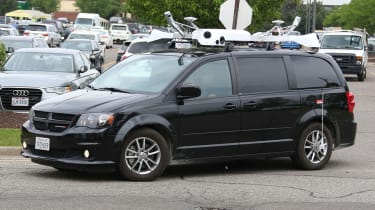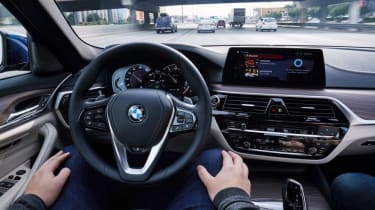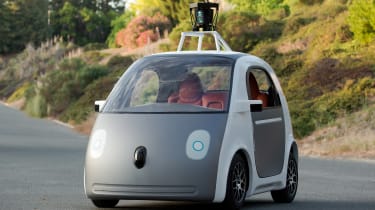Driverless cars: everything you need to know about the autonomous car revolution
Autonomous cars can’t drive you all the way home yet, but the tech is progressing all the time. Here’s all you need to know

Self-driving cars have been a dream of the human race virtually since the car was invented, but it’s only in the last few years that the technology has made driverless cars seem remotely possible, let alone viable for widespread use. Brands like Tesla, Audi and Volvo have put millions into research and development of the tech, but despite plenty of hype about it in the late 2010s the development has stalled in the early 2020s, for various reasons.
Self-driving cars could revolutionise the world we live in, not just the automotive sphere. Driverless car tech could change how we see commuting forever, let alone the insurance industry, the roads we drive on and how we view the act of driving a car itself.
Can you imagine a world where the only time you turn a steering wheel yourself is on a race track? It seems so far off right now, but as we know, technology can leap ahead incredibly quickly. In this article, we’ve investigated the world of driverless car technology to bring you the answers about this new frontier in the automotive world and update you on the status quo.
Driverless cars: where are we now?
In May 2024 the UK Government made a significant step forward with the new Automated Vehicles Act, which allows self-driving cars on UK roads from 2026 that “achieve a level of safety at least as high as careful and competent human drivers”. The UK is one of the only countries in the world to have legal guidance on self-driving cars.
The driverless car will still need a human behind the wheel, but accidents that happen while in autonomous mode will be treated as being the fault of the manufacturer and the car’s insurers will be liable, not the ‘driver’. Under these rules, the driver will not really be a driver at all, but a ‘user-in-charge’.
Another element of the act is to prevent manufacturers from claiming their cars can drive themselves when they actually cannot. An example of this is Tesla, which calls its suite of autonomous driver assist features “full self-driving” and has been in legal trouble in the US for doing so because it may risk misleading consumers.
There are also big questions about whether autonomous cars will actually appear on the roads, even if they are legally allowed. After all, will insurers be willing to cover cars that will rely on this new tech, and if a driver is needed at all times then is there a real benefit to the car’s users? These questions are at the core of how driverless car tech will develop.
As for the actual products, Volvo recently unveiled a fully autonomous version of its XC90 SUV, designed for the ride-hailing application Uber, while BMW and Mercedes entered a partnership to build fully autonomous, consumer-targeted production vehicles as early as 2024.
Car manufacturers are busy forming other partnerships among themselves, to help ease the financial burden of development. Jaguar Land Rover teamed up with the Google-owned technology firm Waymo, with the aim of producing up to 20,000 driverless versions of the all-electric I-Pace, while Toyota and Suzuki entered an agreement in August 2019.
Tesla’s “Autopilot” system is probably the best known semi-autonomous car technology out there and remains under constant development. Currently, it can assume control of the car’s throttle, steering and braking on the motorway. It also features an automatic lane-changing function, an auto-park function and a “summon” feature, allowing the car to automatically drive to its owner in a car park. In the US Teslas can drive themselves in many situations but the driver must be constantly alert and ready to take back control
Currently, the UK is one of the countries leading the way in autonomous vehicle research. However, many manufacturers are realising the scale of financial input required for the technology’s development, and are scaling back their operations. Ford recently realigned its estimate for the arrival of fully autonomous vehicles, while Google’s spin-off driverless vehicle firm, Waymo is unsure whether truly automated cars will be able to cope in adverse weather conditions. There are still massive technical and legislative hurdles to overcome.
The autonomous car roadmap
The word “driverless” is a loaded term in the automotive industry, regarded by some as being misleading, as it will take a decade or more for manufacturers and lawmakers to find the correct combination of technology and legislation to allow a vehicle without direct driver oversight to appear on public roads.
To help define what a ‘driverless car’ can do there are five key stages of automation, separated into levels. Level 1 automation refers to technologies such as adaptive cruise control, lane-keeping assistance and autonomous emergency braking, where the driver and electronics share control of the vehicle. In its most basic form, adaptive cruise control has been in production since the 1990s.
Vehicles fitted with Level 2 autonomous technology can assume full control of their throttle, steering and brakes in controlled circumstances, such as motorway driving or parking. The driver must monitor the system and be ready to regain control, should the electronics be unable to deal with a situation.

Level 2 autonomy is currently the most advanced commercially available version of the technology, and features on cars such as the Tesla Model S and the Mercedes S-Class.
Level 3 and 4-capable vehicles are next. The systems will respectively allow “conditional” and “high” automation on dedicated stretches of motorway, where the vehicle can assume complete control of all its functions without the driver’s supervision. A Level 3 system would expect the driver to reassume control in extenuating circumstances, while a Level 4 system will be able to respond to incidents independently in all cases.
Level 5 autonomy could arrive as soon as 2030 but is hugely challenging. The system would allow a vehicle to complete a journey entirely on its own, in both motorway and city environments without input from the driver at any time. Cars will be wirelessly connected to one another and will communicate with the road infrastructure to make decisions on traffic and journey times.
It’s likely that a conventional steering wheel and pedal box will still feature on most cars. However, beyond 2030, it’s feasible we could see the first commercially available vehicle without a set of manual controls.
Autonomous car development: UK code of practice
The Department for Transport (DfT) has issued a Code of Practice, which dictates how autonomous vehicles should be developed on UK roads. First issued in 2015, the code was designed to promote the “safe trialling and use of automated technologies and services on public roads and places in the UK.”
The three main legal requirements are that the test vehicle is roadworthy, appropriately insured and accompanied by an operative who is ready to reassume control of the car if required. Oddly enough, the law says the operative needn’t be sat in the vehicle and offers the option to regain control of the test car remotely from a tracking vehicle.
Any vehicle testers must inform local communities and law enforcement of their planned development programme and the test vehicles must also abide by local driving laws, sticking to the enforced speed limits. Finally, all test mules must be fitted with a black box to allow police officers and insurers to easily analyse the events of any accident, should the worst happen.

Driverless cars: a legal analysis
Joshua Hughes, Head of Complex Injury at Bolt Burdon Kemp, said: “New legislation to support the development of self-driving cars will be welcomed with open arms.
“Previously, there was concern over the grey area that could exist if someone is injured by a driverless vehicle and where it was difficult to prove who was in control at the time of the accident. In the scenario where a manufacturer was found to be liable, an injured claimant could then find themselves bringing a claim under complex product liability law, rather than motor liability. With this Bill, more certainty and confidence will be instilled in the manufactures, insurers and most importantly, road users.”
How could the UK’s motoring laws change?
What will driverless cars actually mean for the way we drive on UK roads?
Insurance
Initially it was thought that insurers would extend compulsory motoring insurance to cover product liability, to protect motorists if the software in their autonomous vehicle malfunctions when they’re not in control. But new laws mean this may not be necessary.
Some manufacturers, such as Volvo, have confirmed they will provide their own form of insurance for self-driving vehicles.
Specialist insurance broker Adrian Flux has announced it will launch a unique policy, to protect drivers of autonomous vehicles from hacking or software failure, in systems such as self-parking or adaptive cruise control. In any case, the Government and motoring industry wants it to be easy for drivers to make a claim, rather than allowing insurance firms to shift the blame.
Driving licences
The Government makes a clear distinction between highly automated vehicles and fully automated vehicles. In the case of the former, existing licence laws will remain as a driver must be ready to assume control of the vehicle at all times. However, the latter may require changes in legislation, as fully self-driving cars may appeal to drivers who can’t or don’t wish to drive conventional cars.
A report by the House of Lords Science and Technology Committee recently concluded that drivers with existing licences should take a second driving exam in an autonomous car to make sure they're capable of taking back control.
The research showed that drivers of automated vehicles took on average six times longer to respond to emergency braking situations compared with those in non-autonomous cars. The report concluded that drivers of autonomous cars risk becoming "complacent” and trusting the technology too much.
Roadworthiness and maintenance
European and UK roadworthiness standards will need to be revised for driverless car production, including a new category for both parties’ annual MOT test which ensures the performance of autonomous driving systems can be tested cheaply and easily.

Vehicles which can be driven both manually and autonomously could well form a tricky legal minefield. For example, if the vehicle’s manual controls function perfectly, but its autonomous systems are malfunctioning, could it still be deemed roadworthy and pass an MOT?
The Highway Code
Autonomous vehicles can drive more accurately than humans, so the Highway Code will need to change to account for this. As such, autonomous vehicles could be programmed to overtake cyclists at a closer distance. Tailgating may also no longer be an offence – running several automated vehicles close together brings efficiency benefits, with the leading vehicle’s aerodynamic wash reducing the drag on the vehicles behind it.
Autonomous cars to improve the lives of those with limited mobility
One of the biggest benefits that autonomous cars will offer is mobility to those who currently cannot drive. A recent study by the Society of Motor Manufacturers and Traders (SMMT) found that six out of ten people with limited mobility would benefit from an autonomous car.
Of those who agreed their lives would be improved, almost half said they would be able to pursue hobbies outside their home or go out to places like restaurants more often. A further 39 percent said an autonomous vehicle would provide them with better access to healthcare services.
Could autonomous cars “dumb down” driving standards?
Autonomous vehicles are designed to reduce the number of accidents caused by human drivers but, in recent months, we’ve seen that they’re far from faultless. There have been several documented cases of accidents involving autonomous vehicles and overly complacent drivers, leading to a growing concern that an over-reliance on autonomous technology will negatively impact drivers’ ability behind the wheel over time.

In 2017, the House of Lords Science and Technology Committee released a report which discussed this issue. Their main concerns centred on “Level 3” autonomous technology – a system which can assume complete control of the vehicle, allowing the driver to direct their attention elsewhere in all but emergency situations.
Research cited by the Committee found that drivers of automated vehicles took, on average, six times longer to respond to emergency braking situations than drivers of conventional cars. As such, the fear is that the additional freedom brought by “Level 3” capable vehicles will make motorists less attuned to road hazards, making them ill-prepared to regain control of their vehicles when needed.
Road infrastructure
The effectiveness of autonomous technology can vary according to its surroundings. An autonomous vehicle can have all the radar, camera and laser-based guidance available to help it “see'' its environment, but the number of variables in more complex driving situations requires huge amounts of processing power to make sense of the information. The usefulness of driverless cars may ultimately depend on the quality of the road infrastructure and its ability to standardise the driving environment.
Current quality standards for the UK’s road infrastructure vary widely depending on where you drive. A brand-new dual carriageway will be perfectly laid out, with defined white lines and clear signage but, over time, the quality of the road markings and clarity of the signage will deteriorate, making it more difficult for autonomous vehicles to operate correctly.
Narrow lanes in rural areas could pose a different challenge for autonomous vehicles. If there are no white lines defining the edge of the road, will the vehicle be able to “see” where the tarmac ends? What happens if the autonomous vehicle meets an oncoming vehicle? Will it be able to locate a passing place?
In the UK, many country lanes are covered by 60mph national speed limit. Would an autonomous vehicle attempt to constantly attain this speed, regardless of the road’s twistiness and width? All of these scenarios will need to be trialled before full autonomy can be expected to work as effectively as a driver at the wheel.
Autonomous cars by manufacturer: an A – Z
Apple

Apple was involved in a secretive autonomous vehicle development scheme called Project Titan, but it was cancelled in early 2024. The American technology giant revealed that its plans of building a car had been abandoned and the company was instead looking to develop technology that it could sell to manufacturers of autonomous vehicles.
BMW

BMW launched level three autonomous driving in its new 7 Series in 2024 with its BMW Highway Assistant tech (level 2) and BMW Personal Pilot (level 3) software. It can keep the car in lane on the motorway at up to 130 km/h (81 mph), and the driver can take their hands off the wheel as long as they pay attention.
The level 3 tech allows drivers to look away briefly while in a traffic jam at up to 60 km/h (37 mph) while the car handles the driving itself. BMW says that “the driver must always be prepared to reassume control within a few seconds when prompted by the car,” though.
Ford

Ford recently toned down its expectations for what its autonomous vehicles will be capable of. The American manufacturer previously stated that its first autonomous car would operate without any conventional controls within geo-fenced areas; a statement which the firm has since revised. Jim Hackett, CEO of Ford, said the applications of its autonomous vehicle “will be narrow – what we call geo-fenced – because the problem is so complex.”
However, the brand’s Mustang Mach-E electric car was the first model to drive on a UK motorway legally with a driver not holding the wheel. The car uses a camera to check that the driver is looking at the road ahead at all times. Ford calls it a level 2 (or 2+) tech.
Google/Waymo

Google (and its autonomous vehicle spin-off brand, Waymo) has dabbled in self-driving vehicle technology in the United States. The technology giant has been real-world testing near Silicon Valley since 2009, using its own autonomous pods and a fleet of modified production vehicles.
Waymo operates driverless taxis in San Francisco, Los Angeles, and Phoenix. Currently over 100,000 people per week use a Waymo taxi to get to a local destination, but the cars are limited on which roads they can use.
However, the brand’s confidence in the technology has been shaken. Waymo’s CEO, John Krafcik, recently said that truly autonomous cars will never exist and that they will always require some form of “user interaction.”
Honda
A couple of years ago, Honda expressed its intentions of launching Level 3 autonomous- capable vehicles next year and Level 4 capable vehicles by 2025. However, little further information has since been released on the project.
Hyundai

Hyundai’s research ranges from remotely maintaining and servicing your car to fully autonomous vehicles, and the brand says driverless cars will be with us by 2030. It launched Motional in 2023, a brand dedicated to driverless taxis, and in Boston, USA has begun working on an Ioniq 5 robotaxi project. It’s a level 4 autonomous taxi that can operate without a driver at all.
Jaguar Land Rover

Jaguar Land Rover has been testing autonomous vehicles since 2017 and has developed self-driving friendly tech such as a 3D head-up display, as well as a system which projects an autonomous vehicle’s direction of travel onto the road, informing other road users of its intentions. The brand also recently announced three new tech hubs in Germany, Italy and Spain (alongside existing ones in USA, Hungary, Ireland, UK, China and India) that are working on artificial intelligence (AI) tech in relation to self-driving cars.
Kia
Kia began publicly testing Level 4 autonomous cars at the start of 2019, with the intention of releasing the technology on its production cars from 2021. While the first Level 4 cars will only be available in “smart cities,” the brand expects that, by 2025, it will be able to offer the technology to fleet customers. The Korean marque had invested $2 billion in driverless research and development at the end of 2018.
Mazda
Mazda has no fully autonomous programme, but is keen to develop more advanced assistance systems. Such as its Co-Pilot Concept2 which is set to be standard across all its models by 2025.
Mercedes
Mercedes entered a partnership with BMW, which promised to develop Level 4 autonomous-capable vehicles (which operate within specific geofenced areas) by 2024, but it’s clear now that there is still work to do. The German brand unveiled its all-electric EQS concept at the 2019 Frankfurt Motor Show, which is capable of Level 3 autonomy. The brand was the first car maker to sell level 3 autonomous tech in the US market (California and Nevada only) in its cars, which allows driving without holding the wheel on certain roads.
Mercedes is also backing autonomy for ride-sharing, with the brand having acquired a stake in Uber. Its F 015 Luxury in Motion concept shows what future autonomous cars may look like.
Stellantis (Peugeot, Citroen, DS, Vauxhall)
Stellantis says that it offers level 2 autonomy in its cars already and that “research on Level 3 and 4 solutions is already well progressed.” The large automotive group has entered into several testing schemes for self-driving tech already.
For example DS was granted permission by the French government to test its vehicles on public roads in 2017, in an agreement which includes licenced testing by non-expert drivers. A fleet of 20 autonomous cars were based around Velizy, Central France, and were used by members of the public.
However, Peugeot previously revealed that implementing autonomous technology in one of the brand’s production vehicles would add €15,000 (roughly £13,000) to its list price. As such, Stellantis as a whole will likely not sell anything beyond Level 3-capable cars to members of the public for the foreseeable future.
Renault
Renault has taken a bold step away from autonomous driving this year as it says it adds too much cost to vehicles and customers don’t want the technology. However, the development of self-driving tech will still happen at Renault, just with a focus on public transport and commercial applications rather than for passenger cars.
Tesla

Tesla has talked the talk for years on autonomous driving and its cars have been available with a level 2 autonomous driving system for quite a while. However, it has recently come under fire for various issues with the tech mainly related to overstated promises made by the firm and its world-famous boss Elon Musk.
Owners have complained about issues such as paying for an option called ‘full self-driving’ which has never arrived as well as poor implementation of tech on existing cars. Search online for Tesla self-driving and you’ll find a lot of experiences from owners where the tech has failed them, which has prompted some to claim Tesla is using real customers as a test-bed for its systems rather than proving the technology works before launching it.
Another example is that Musk claimed that drivers would be able to safely fall asleep behind the wheel of one of his cars by 2021. That didn’t happen and doesn’t look likely for some time yet.
Toyota
Toyota ramped up its autonomous research and development programme through its $1bm (£720m) Research Institute, which introduced its next-generation autonomous mule (based on the Lexus LS 600h L) at the 2018 Consumer Electronics Show. It followed up with the launch of ‘Teammate’, a term used for tech that helps drivers stay safe on the motorway (like lane assist).
The brand’s most recent announcement is an attempt to keep pace with rivals in China by launching a car capable of “advanced driving assistance for parking and navigation on highways and urban traffic” using tech from a firm linked to Mercedes-Benz’s similar set-up.
Volvo

In 2019 Volvo unveiled a fully autonomous production-ready version of the XC90, built for the ride-hailing application Uber. The car was equipped with back-up systems for steering and brakes, so it could safely bring itself to a stop if the main driverless systems fail. The brand then launched the 360c concept car, a fully autonomous pod that showcases a standardised system to link all the driverless cars on the road together. There is also an autonomous driving feature called “Ride Pilot” available to some Volvo customers in California in the US that keeps pace with similar self-driving tech from other luxury car brands.
Volkswagen Group

Audi is spearheading the Volkswagen Group’s autonomous car effort. The latest Audi A8 has “Level 3” autonomous tech, while Audi is also focusing on infrastructure projects, so cars can talk to each other, and other road tech like traffic lights. We also previously saw Audi actively testing an autonomous RS7 on track, teaching systems how to cope with extreme scenarios and surfaces with low levels of grip.
Volkswagen has also been developing a level 4 autonomous vehicle for use in the commercial sector called the ID. Buzz AD. It’s based on the electric van and has been built with help from autonomous tech firm Mobileye.
What do you think about the prospect of driverless cars coming to UK roads? let us know in the comments section below...






